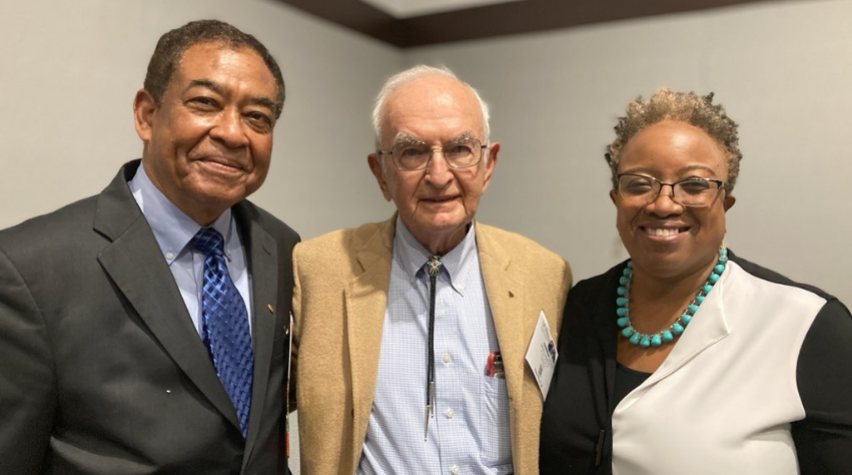
Gerald Lessells (center) was among the pioneers recognized at a 2021 Minority Affairs Committee celebration of its history. Lessells was joined by Otis Shelton (left), who in 2014 became AIChE’s first Black president; and Christine Grant (right), AIChE’s 2022 president. Photo credit: Doug Lessells
This article references material presented in a February 2022 CEP Magazine article about AIChE’s Minority Affairs Committee (MAC), and material from a comprehensive history of MAC published by AIChE in 2015.
In observance of Black History Month 2022, ChEnected will present posts that reflect on the progress of Black engineers — within and beyond the AIChE community.
AIChE recently broadened its approach to improving equity, diversity, and inclusion (EDI) through its adoption of the IDEAL path. As envisioned by then-AIChE-Director Cato Laurencin, the IDEAL path supplements EDI’s (or IDE’s) aspirational components of inclusiveness, diversity, and equity with deliberate action in the form of anti-racism and learning. IDEAL proposes that the path toward a more fair and just society must actively confront systemic racism in the workforce and in institutions.
Gerald Lessells: An early ally
Within AIChE, individual actions to eliminate barriers to inclusion extend back to at least the 1960s, when some AIChE members stepped up to change the status quo.
One early ally was Gerald Lessells, who since the 1960s has been a driver for equity and inclusion in the profession and within AIChE. A retired chemical engineer and former Director of AIChE, Lessells was a guest of honor at a November 2021 gathering of AIChE’s Minority Affairs Committee (MAC). The Committee celebrated the efforts of some of its pioneers at a 30th anniversary session, held at the AIChE Annual Meeting in Boston, Massachusetts.
In comments delivered at the MAC session, and in recent interviews — including a story published in the Feb 2022 issue of CEP magazine — Lessells described the situation that he and other allies encountered in trying to open doors in the profession.
During the 1960s — with the passage of the Civil Rights Act and activism directed at overturning codified racism — Lessells was becoming frustrated with his profession.
“I considered chemical engineering to be a ‘lily-white’ and almost-exclusively male profession — and I knew we were missing a lot of talent,” said Lessells.
“In my 15 years in industry, up until 1965, I had met only one Black chemical engineer, while I was working at Mobil, and only one female chemical engineer, who was in my 1950 MIT chemical engineering class of 142 graduates.”
A member of AIChE, Lessells decided to approach the Institute’s leadership, where he immediately hit a snag: No one else saw the problem. “Believe it or not, it took me almost a year and a half to find someone who would listen to me,” Lessells says.
Gaining support
Taking up the story, as told by CEP contributor Stephanie Pappas:
Lessells says that the attitude among AIChE leaders was that the Institute worked for its members, who were, by and large, not minorities; ergo, recruiting and retaining minority engineers was not part of the scope of the organization. Lessells kept pushing, turning happenstance meetings into opportunities. In 1967, he met Henry Brown at a New Year’s Eve party and recruited the MIT chemical engineering alum, who was Black and who had been active in the civil rights movement, to the cause. Later, during a family vacation, Lessells happened to meet another engineer, J. Frank Valle-Riestra, who was originally from Peru and who was working to build minority-focused programs in his AIChE local section in California. That meeting bolstered Lessells’ conviction that AIChE needed to do more at the organization-level.
Lessells eventually found a receptive ear in Hugh Guthrie, who was elected AIChE president in 1969. Guthrie launched a task force called the Career Guidance Subcommittee for Disadvantaged Youth. The group operated on a shoestring budget, trying to urge local AIChE sections to start their own outreach programs for minority youth. It was an uphill battle, particularly because there were few engineers within the local sections from minority communities, and few white engineers interested in taking up the cause.
Recognizing pivotal leaders
In addition to honoring Lessells, MAC, at its recent celebration, recognized Brown, Wei, and Osborne-Lee for their pivotal contributions to minority engineers in AIChE.
Looking back on those efforts, Lessells says, “There is no question in my mind that the greatest single accomplishment was in changing the mindset of AIChE leadership to see that we had an obligation to do what I was suggesting. I knew the profession would benefit by tapping a larger pool of talent, and opening opportunities to those previously denied them. Society in general would benefit from this, too."


